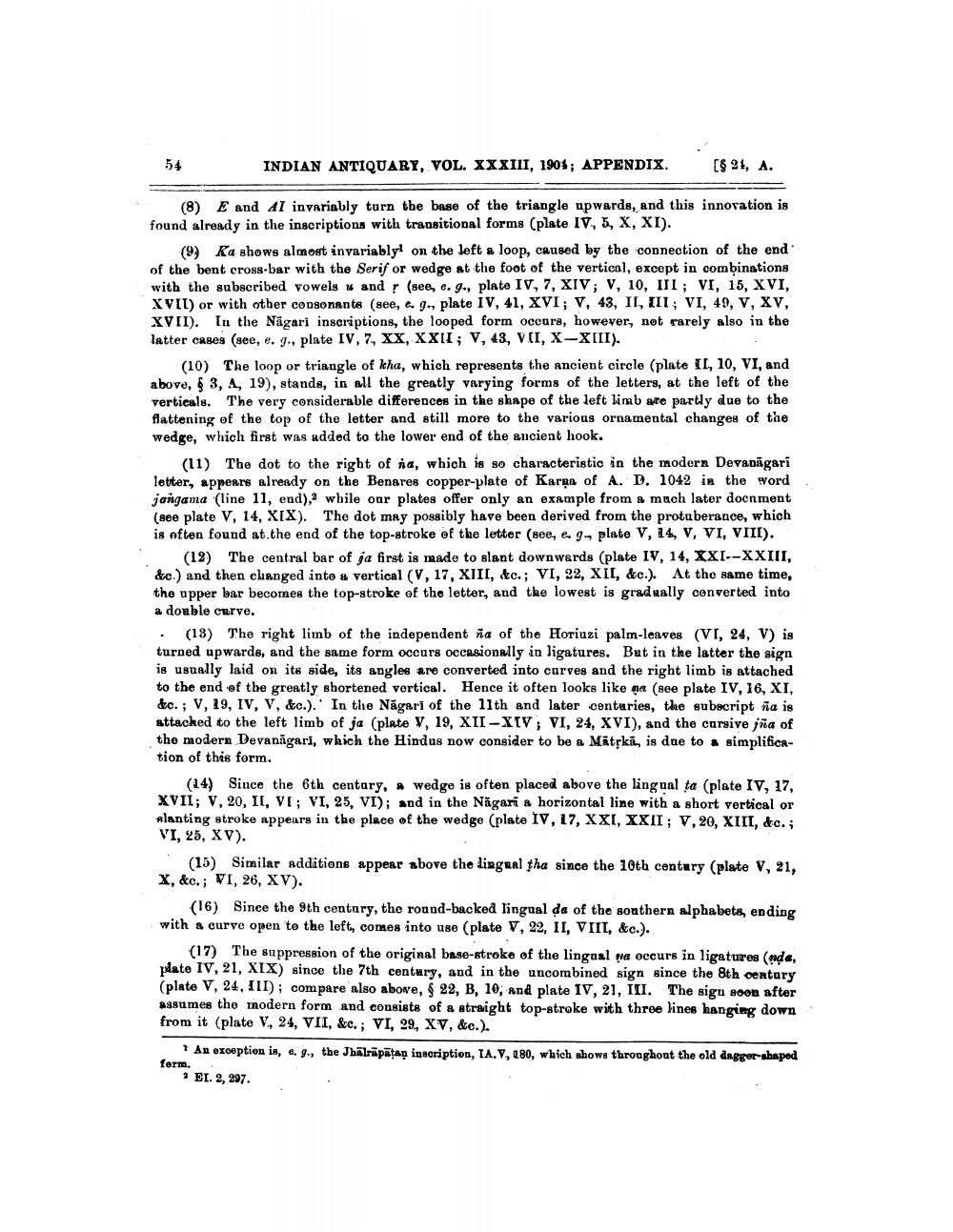________________
54
INDIAN ANTIQUARY, VOL. XXXIII, 1903; APPENDIX.
[$ 21, A.
(8) E and AI invariably turn the base of the triangle upwards, and this innovation is found already in the inscriptions with transitional forms (plate IV, 5, X, XI).
(9) Ka shows almost invariably on the left a loop, caused by the connection of the end of the bent cross-bar with the Serif or wedge at the foot of the vertical, except in combinations with the subscribed vowels and r (see, e. g., plate IV, 7, XIV; V, 10, II; VI, 15, XVI, XVII) or with other consonants (see, . ., plate IV, 41, XVI; V, 43, II, III; VI, 49, V, Xv, XVII). In the Nägari inscriptions, the looped form occurs, however, not rarely also in the latter cases (see, e. g., plate IV, 7, XX, XXII; V, 43, VII, X-XIII).
(10) The loop or triangle of kha, which represents the ancient circle (plate II, 10, VI, and above, $ 3, 4, 19), stands, in all the greatly varying forms of the letters, at the left of the verticals. The very considerable differences in the shape of the left limbare partly due to the flattening of the top of the letter and still more to the various ornamental changes of the wedge, which first was added to the lower end of the ancient hook.
(11) The dot to the right of na, which is so characteristic in the modern Devanāgari letter, appears already on the Benares copper-plate of Karna of A. D. 1042 in the word jangama (line 11, end), while our plates offer only an example from a much later doenment (see plate V, 14, XIX). The dot may possibly have been derived from the protuberance, which is often found at the end of the top-stroke of the letter (see, e. 9. plate V, 14, V, VI, VIII).
(12) The central bar of ja first is made to slant downwards (plate IV, 14, XXI.-XXIII, &c.) and then changed into a vertical (V, 17, XIII, &c.; VI, 22, XII, &c.). At the same time, the upper bar becomes the top-stroke of the letter, and the lowest is gradually converted into a double curve. . (18) The right limb of the independent na of the Horiuzi palm-leaves (VI, 24, V) is turned upwards, and the same form occurs occasionally in ligatures. But in the latter the sign is usually laid on its side, its angles are converted into carves and the right limb is attached to the end of the greatly shortened vertical. Hence it often looks like na (see plate IV, 16, XI, &c.; V, 19, IV, V, &c.). In the Nāgari of the 11th and later centuries, the subscript fia is attacked to the left limb of ja (plate V, 19, XII-XIV; VI, 24, XVI), and the carsive jña of the modern Devanagari, which the Hindus now consider to be a Mätşkā, is due to a simplification of this form.
(14) Since the 6th centary, # wedge is often placed above the lingual ta (plate IV, 17, XVII; V, 20, II, VI; VI, 25, VI); and in the Nāgari a horizontal line with a short vertical or #lanting stroke appears in the place of the wedge (plate IV, 17, XXI, XXII; V, 20, XIII, &c.; VI, 25, XV).
(15) Similar additions appear above the lingual tha since the 10th century (plate V, 21, X, &c.; VI, 26, XV).
(16) Since the 9th century, the round-backed lingual da of the sonthern alphabets, ending with a curve open to the left, comes into use (plate V, 22, II, VIII, &c.).
(17) The suppression of the original base-stroke of the lingaal ma occurs in ligatures (nda, plate IV, 21, XIX) since the 7th century, and in the uncombined sign since the 8th oentary (plate V, 24, III); compare also above, $ 22, B, 10, and plate IV, 21, III. The sigu soon after assumes the modern form and consists of a straight top-stroke with three lines hanging down from it (plate V, 24, VII, &c.; VI, 29, XV, &c.).
1 An exoeption is, e. g., the Jhalrūpatan inscription, IA.V,180, which shows throughout the old dagger shaped form.
1 EL. 2, 297.




